McDonnell F-101 Voodoo Video - Overview
|
|
McDonnell F-101 Voodoo
F-101 Voodoo
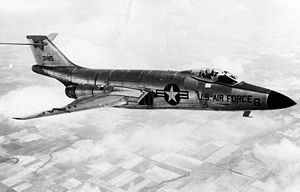
Picture - McDonnell F-101A Voodoo
Role: Fighter aircraft
Manufacturer: McDonnell Aircraft
First flight: 29 September 1954
Introduced: May 1957
Retired: 1972, USAF
1982, US ANG
1984, Canada
Primary user: United States Air Force
Number built: 807
Unit cost: US$1,276,145 (RF-101C)
US$1,754,066 (F-101B)
Developed from: XF-88 Voodoo
Variants: CF-101 Voodoo
The McDonnell F-101 Voodoo was a supersonic military fighter flown by the USAF and the RCAF. Initially designed by McDonnell Aircraft as a long-range bomber escort (known as a penetration fighter) for the Strategic Air Command (SAC), the Voodoo was instead developed as a nuclear armed fighter bomber for the Tactical Air Command (TAC), and as a photo reconnaissance aircraft based on the same airframe. Extensively modified versions were produced as an all-weather interceptor aircraft, serving with the Air Defense Command, later renamed the Aerospace Defense Command (ADC), the Air National Guard, the Royal Canadian Air Force and the unified Canadian Forces after 1968.
The Voodoo's career as a strike fighter was relatively brief, but the reconnaissance versions served for some time. Along with the US Air Force's U-2 and US Navy's RF-8 Crusaders, the RF-101 reconnaissance variant of the Voodoo was instrumental during the Cuban Missile Crisis and saw extensive service during the Vietnam War. Interceptor versions served with the Air National Guard until 1982, and in Canadian service they were a front line part of NORAD until their replacement with the CF-18 Hornet in the 1980s.
While the Voodoo was a moderate success, it may have been more important as an evolutionary step towards its replacement in most roles, the F-4 Phantom II, one of the most successful Western fighter designs of the 1960s. The Phantom would retain the twin engines, twin crew for interception duties, and a tail mounted well above and behind the jet exhaust. Both aircraft were influenced by the same company's F-3 Demon, a carrier-based naval fighter-interceptor that served during the 1950s and early 1960s.
All models of the aircraft were known by the nickname "One-oh-Wonder" and this was reflected on the aircraft type patches worn by crews.
Design and development
Initial design on what would eventually become the Voodoo began just after World War II in response to a USAAF Penetration Fighter Competition in 1946 for a long-range high performance fighter to escort bombers, much as the P-51 Mustang had done in its time. After being awarded a contract (AC-14582), McDonnell built two prototypes, designated the XF-88 Voodoo. The first prototype (#46-6525), powered by two 3,000 lbf (13.3 kN) Westinghouse XJ34-WE-13 turbojets, flew from Muroc on 20 October 1948. Preliminary testing revealed that the top speed was a disappointing 640 mph (1,030 km/h) at sea level. After fitting McDonnell-designed afterburners, thrust was increased by 30% with corresponding performance increases in top speed, initial rate of climb and reduced takeoff distance.
Although the XF-88 won the "fly-off" competition against the competing Lockheed XF-90 and North American YF-93, the USAF (created in 1947) reevaluated the need for bomber escort and terminated the Penetration Fighter program in 1950. Analysis of Korean war missions, however, revealed that contemporary USAF strategic bombers were vulnerable to fighter interception. In 1951, the USAF issued a new requirement for a bomber escort with all major US manufacturers submitting designs. The McDonnell design was a larger and higher powered version of the XF-88, and won the bid in May 1951. The F-88 was redesignated the F-101 Voodoo in November 1951.
Design changes for new engines
The new design was considerably larger, carrying three times the initial fuel load and designed around larger, more powerful Pratt & Whitney J57 turbojets. The greater dimensions of the J57 engines required modifications to the engine bays, and modification to the intakes to allow a larger amount of airflow to the engine. The new intake also was designed to be more efficient at higher Mach numbers. In order to increase aerodynamic efficiency, reduce structural weight and alleviate "pitch-up" phenomena recently identified in flight testing of the D-558-2, an aircraft with a control surface configuration similar to the XF-88, the horizontal tail was relocated to the top of the vertical stabilizer, giving the F-101 its signature "T-tail". In late 1952, the mission of the F-101 was changed from "penetration fighter" to "strategic fighter", which entailed equal emphasis on both the bomber escort mission and on nuclear weapons delivery. The new Voodoo mock-up with the reconfigured inlets, tail surfaces, landing gear, and dummy nuclear weapon was inspected by Air Force officials in March 1953. The design was approved, and an initial order for 39 F-101As was placed on 28 May 1953, no prototypes being required as the F-101 was considered a simple development of the XF-88.
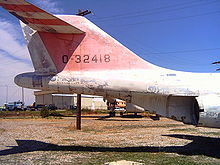
Picture - F-101A, AF Serial No. 53-2418, at Pueblo Weisbrod Aircraft Museum, Pueblo, CO
First production
Serial number 53-2418 was the first production A-model delivered to Edwards AFB in August 1954. Its maiden flight was on 29 September 1954, with a McDonnell test pilot Robert C. Little. Test flight results: Mach 0.9 at 35,000 ft (10,500 m), with a maximum test speed to Mach 1.4. This aircraft is on display at the Pueblo Weisbrod Aircraft Museum, Pueblo Memorial Airport, Pueblo, CO.
The end of the war in Korea and the development of the jet-powered B-52 negated the need for fighter escort and Strategic Air Command withdrew from the program.
Operational history
F-101A / RF-101G
Despite SAC's loss of interest, the aircraft attracted the attention of Tactical Air Command, and the F-101 was reconfigured as a fighter bomber, intended to carry a single nuclear weapon for use against battlefield targets such as airfields. With the support of TAC, testing was resumed, with Category II flight tests beginning in early 1955. A number of problems were identified during development, with many of these fixed. The aircraft had a dangerous tendency toward severe pitch-up at high angle of attack that was never entirely solved. Around 2,300 improvements were made to the aircraft in 1955-56 before full production was resumed in November 1956.
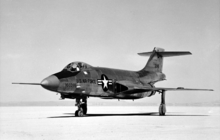
Picture - F-101A Voodoo
The first F-101A was delivered in May 1957 to the 27th Strategic Fighter Wing, replacing their F-84F Thunderstreak. The F-101A was powered by two Pratt & Whitney J57-P-13 turbojets, allowing good acceleration, climb-performance, ease in penetrating the sound barrier in level flight, and a maximum performance of Mach 1.52. The F-101's large internal fuel capacity allowed a range of approximately 3,000 mi (4,828 km) nonstop. The aircraft was fitted with an MA-7 fire-control radar for both air-to-air and air-to-ground use, augmented by an MA-2 Low Altitude Bombing System (LABS) system for delivering nuclear weapons, and was designed to carry a Mk 28 nuclear bomb. The original intended payload for the F-101A was the McDonnell Model 96 store, a large fuel/weapons pod similar in concept to that of the B-58 Hustler, but was cancelled in March 1956 before the F-101 entered service. Other operational nuclear payloads included the Mk 7, Mk 43, and Mk 57 weapons. (While theoretically capable of carrying conventional bombs, rockets, or Falcon air-to-air missiles, the Voodoo never used such weapons operationally). It was fitted with four 20mm M39 cannon, with one cannon often removed in service to make room for a TACAN beacon-receiver.
The F-101 set a number of speed records, including: a JF-101A setting a world speed record of 1,207 mph (1,942 km/h) on 12 December 1957 during "Operation Firewall", handily beating the previous record set by the Fairey Delta 2. On 27 November 1957, during "Operation Sun Run," an RF-101C set the Los Angeles-New York-Los Angeles record in 6 hours 46 minutes, the New York to Los Angeles record in 3 hours, 36 minutes, and the Los Angeles to New York record in 3 hours 7 minutes. An F-101A flew from Carswell, Texas to Bermuda without refueling.
A total of 77 F-101As were built. They were gradually withdrawn from service starting in 1966. Twenty-nine survivors were converted to RF-101G specifications with a modified nose, housing reconnaissance cameras in place of cannons and radar. These served with the Air National Guard through 1972.
RF-101A
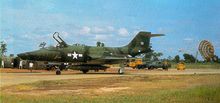
Picture - A 33rd Tactical Group RF-101A (s/n 54-1512) at Tan Son Nhut Air Base, 1965.
In October 1953, the USAF requested that two F-101As be built as prototype YRF-101A tactical reconnaissance aircraft. These were followed by 35 RF-101A production aircraft. The RF-101A shared the airframe of the F-101A, including its 6.33 g (62 m/s²) limit, but replaced the radar and cannons with up to six cameras in the reshaped nose. Like all other models of the F-101, it had provision for both flying boom and probe-and-drogue in-flight refueling capability, as well as for a buddy tank that allowed it to refuel other aircraft. It entered service in May 1957, replacing the RB-57 Canberra.
USAF RF-101As from the 363d Tactical Reconnaissance Wing at Shaw AFB, SC flew reconnaissance sorties over Cuba during the Cuban Missile Crisis in October 1962.
In October 1959, eight RF-101As were transferred to Taiwan, which used them for overflights of the Chinese mainland. These ROCAF RF-101A with modified C-model vertical fins with air intake. The intake is used to cool the drag chute compartment and eliminates the 5-minute limit on using the afterburners on the A model. Two were reportedly shot down.
F-101B / CF-101B / EF-101B
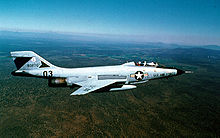
Picture - A two-seat McDonnell F-101B Voodoo of the Oregon Air National Guard
In the late 1940s, the Air Force had started a research project into future interceptor aircraft that eventually settled on an advanced specification known as the 1954 interceptor. Contracts for this specification eventually resulted in the selection of the F-102 Delta Dagger, but by 1952 it was becoming clear that none of the parts of the specification other than the airframe would be ready by 1954; the engines, weapons and fire control systems were all going to take too long to get into service. An effort was then started to quickly produce an interim supersonic design to replace the various subsonic interceptors then in service, and the F-101 airframe was selected as a starting point.
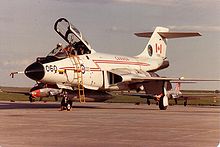
Picture - CF-101 Voodoo 101060 from 409 "Nighthawk" Squadron, CFB Comox on the ramp at CFB Moose Jaw in spring 1982.
Although McDonnell proposed the designation F-109 for the new aircraft (which was to be a substantial departure from the basic Voodoo), the USAF assigned the designation F-101B. The Voodoo featured a modified cockpit to carry a crew of two, with a larger and more rounded forward fuselage to hold a Hughes MG-13 fire control radar. It had transponders linking it to the Semi-Automatic Ground Environment (SAGE) system, allowing ground controllers to steer the aircraft towards its targets by making adjustments through the plane's autopilot. The F-101B had more powerful Pratt & Whitney J57-P-55 engines, making it the only Voodoo not using the -13 engines. The new engines featured a substantially longer afterburner than J57-P-13s. To avoid a major redesign, the extended afterburners were simply allowed to extend out of the fuselage by almost 8 ft (2.4 m). The more powerful engines and aerodynamic refinements allowed an increased speed of Mach 1.85.
The F-101B had no cannons; instead, it carried six AIM-4 Falcon air-to-air missiles, arranged three apiece on a rotating pallet in the fuselage weapons bay. The initial load was two GAR-1 (AIM-4A) semi-active radar homing and two GAR-2 (AIM-4D) infrared-guided weapons with one of each carried on each side of the rotating pallet. After the first two missiles were fired, the door turned over to expose the second pair. Standard practice was to fire the weapons in SARH/IR pairs to increase the likelihood of a hit. Late-production models had provision for two 1.7-kiloton MB-1/AIR-2 Genie nuclear rockets on one side of the pallet in place of the Falcons, and Project "Kitty Car" upgraded most earlier F-101Bs to this standard beginning in 1961.
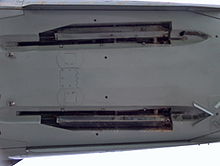
Picture - The AIM-4 Falcon side of the F-101B missile door
From 1961 through 1966, F-101Bs were upgraded under Project 'Bright Horizon', fitting them with an infrared sighting and tracking (IRST) system in the nose in place of the standard in-flight refueling probe.
The F-101B was made in greater numbers than the F-101A, with a total of 479 being delivered by the end of production in 1961. Most of these were delivered to the Air Defense Command (ADC) beginning in January 1959. The only foreign customer for the F-101B was Canada. For more details on the history of the Voodoo in Canada, see CF-101 Voodoo.
The F-101B was withdrawn from ADC service from 1969 to 1972. Surviving USAF aircraft were transferred to the Air National Guard, where they served until 1982.
TF-101B / F-101F / CF-101F
Some of the F-101Bs were completed as dual-control operational trainer aircraft initially dubbed TF-101B, but later redesignated F-101F. Seventy-nine new-build F-101Fs were manufactured, and 152 more existing aircraft were later modified with dual controls. Ten of these were supplied to Canada under the designation CF-101F. These were later replaced with 10 updated aircraft in 1971.
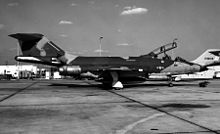
Picture - The prototype RF-101B (s/n 57-0301).
RF-101B
In the early 1970s, a batch of 22 ex-RCAF CF-101Bs were returned to the USAF and converted to RF-101B reconnaissance aircraft with their radar and weapons bay replaced with a package of three KS-87B cameras and two AXQ-2 TV cameras. An in-flight refueling boom receptacle was fitted. These aircraft served with the 192nd Tactical Reconnaissance Squadron of the Nevada Air National Guard through 1975. They were expensive to operate and maintain and had a short service life.
F-101C / RF-101H
The F-101A fighter-bomber had been accepted into Tactical Air Command (TAC) service despite a number of problems. Among others, its airframe had proven to be capable of withstanding only 6.33-g (62 m/s²) maneuvers, rather than the intended 7.33 g (72 m/s²). An improved model, the F-101C, was introduced in 1957. It had a 500 lb (227 kg) heavier structure to allow 7.33-g maneuvers as well as a revised fuel system to increase the maximum flight time in afterburner. It was also fitted with an underfuselage pylon for carrying atomic weapons, as well as two hardpoints for 450-gallon drop tanks. Forty-seven were produced.
Originally serving with the 27th Tactical Fighter Wing at Bergstrom AFB, Texas, the aircraft were transferred in 1958 to the 81st Tactical Fighter Wing which operated three squadrons from the twin RAF air stations Bentwaters & Woodbridge. The 78th Tactical Fighter Squadron was stationed at Woodbridge, while the 91st and 92nd were stationed at Bentwaters. The 81st TFW served as a strategic nuclear deterrent force, the Voodoo's long range putting almost all of the Warsaw Pact countries, and targets up to 500 miles deep into the Soviet Union within reach.
Both the A and C model aircraft were assigned to the 81st TFW, and were used interchangeably within the three squadrons. Operational F-101A/C were upgraded in service with Low Angle Drogued Delivery (LADD) and Low Altitude Bombing System (LABS) equipment for its primary mission of delivering nuclear weapons at extremely low altitudes. Pilots were trained for high speed, low level missions into Soviet or East Bloc territory, with primary targets being airfields. Although these were not discussed as one-way missions, it was assumed by all involved that chances of the pilots returning after delivering their weapons was virtually zero.
The F-101C never saw combat and was replaced in 1966 with the F-4C Phantom II. Thirty-two aircraft were later converted for unarmed reconnaissance use under the RF-101H designation. They served with Air National Guard units until 1972.
RF-101C
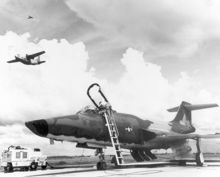
Picture - U.S. Air Force technicians prepare a McDonnell RF-101 Voodoo for a photo reconnaissance mission
Using the reinforced airframe of the F-101C, the RF-101C first flew on 12 July 1957, entering service in 1958. Like the RF-101A, the RF-101C had six cameras in place of radar and cannons in the reshaped nose. Unlike the RF-101A, the RF-101C retained the ability to carry a single nuclear weapon on the centerline pylon. 166 RF-101Cs were built, including 96 originally scheduled to be F-101C fighter-bombers.
The 1964 Project "Toy Tiger" fitted some RF-101C with a new camera package and a centerline pod for photo-flash cartridges. Some were further upgraded under the Mod 1181 program with automatic control for the cameras.
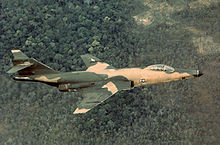
Picture - U.S. Air Force McDonnell RF-101C over Vietnam, 1967.
The RF-101C saw service during the Cuban Missile Crisis and soon followed the F-100 Super Sabres into combat when RF-101s from the 67th Tactical Reconnaissance Wing deployed to Vietnam in October 1961. The RF-101C saw heavy service during the Vietnam War, with the first F-101 being lost in November 1964 to ground fire. From 1965 through November 1970, its role was gradually taken over by the RF-4C Phantom II. In some 35,000 sorties, 39 aircraft were lost, 33 in combat, including five to SAMs, one to an airfield attack, and one in air combat to a MiG-21 in September 1967. The RF-101C's speed made it largely immune to MiG interception. 27 of the combat losses occurred on reconnaissance missions over North Vietnam. In April 1967, ALQ-71 ECM pods were fitted to provide some protection against SAMs. Although the Voodoo was again able to operate at medium altitudes, the added drag decreased the speed enough to make RF-101 vulnerable to MiGs and thus requiring fighter escort.
On 27 November 1957 during Operation Sun Run, an RF-101C piloted by then-Captain Robert Sweet set the Los Angeles-New York-Los Angeles record in 6 hours 46 minutes, and the New York to Los Angeles record in 3 hours, 36 minutes. Another RF-101C, piloted by then-Lieutenant Gustav Klatt, set the Los Angeles to New York record in 3 hours 7 minutes.
After withdrawal from Vietnam, the RF-101C continued to serve with USAF units through 1979.
In service, the RF-101C was nicknamed the "Long Bird;" it was the only version of the Voodoo to see combat.
Variants
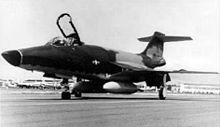
Picture - RF-101C-55-MC (56-0220), assigned to 18th TRS, 460th TRW. This aircraft was shot down by a SAM over North Vietnam on 7 March 1966, killing the pilot.
Section source: Angelucci, 1987. The American Fighter
F-101A
initial production fighter bomber, 77 produced.
NF-101A
one F-101A used by General Electric for testing of the General Electric J79 engine.
YRF-101A
two F-101As built as prototype reconnaissance models.
RF-101A
first reconnaissance version, 35 built.
F-101B
two-seat interceptor, 479 built.
CF-101B
112 F-101Bs transferred to Royal Canadian Air Force (RCAF).
RF-101B
22 ex-RCAF CF-101B modified for reconnaissance use.
TF-101B
dual-control trainer version of F-101B, redesignated F-101F, 79 built.
EF-101B
single F-101B converted for use as a radar target and leased to Canada.
NF-101B
F-101B prototype based on the F-101A airframe; the second prototype was built with a different nose.
F-101C
improved fighter-bomber, 47 built.
RF-101C
reconnaissance version of F-101C airframe, 166 built.
F-101D
proposed version with General Electric J79 engines, not built.
F-101E
another J79 proposal, not built.
F-101F
dual-control trainer version of F-101B; 79 re-designated TF-101Bs plus 152 converted F-101B.
CF-101F
RCAF designation for 20 TF-101B/F-101F dual-control aircraft.
TF-101F
24 dual-control versions of F-101B, re-designated F-101F (these are included in the -F total).
RF-101G
29 F-101As converted for ANG reconnaissance.
RF-101H
32 F-101Cs converted for reconnaissance use.
Operators
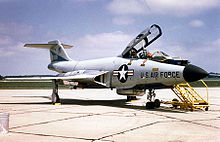
Picture - McDonnell F-101B of the 18th Fighter-Interceptor Squadron, Grand Forks AFB, ND
Canada
Royal Canadian Air Force
Canadian Forces
Republic of China (Taiwan)
Republic of China Air Force
United States
United States Air Force
Aircraft on display
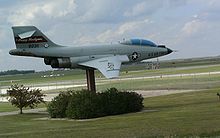
Picture - F-101F AF Serial Number 58-0311, located at Devils Lake Regional Airport, North Dakota
Below is a list of F-101s on display, including museums with an F-101 (CF-101) in their collection:
Canada
CFB North Bay (22 Wing), North Bay, Ontario (CF-101)
Abbotsford International Airport, Abbotsford, British Columbia (CF-101B CAF S/N 101035, former USAF Ser. No. 57-0363 )
Air Force Heritage Park, Winnipeg, Manitoba (CF-101B)
Alberta Aviation Museum, Edmonton, Alberta (CF-101B)
Atlantic Canada Aviation Museum, Halifax, Nova Scotia (CF-101)
Bagotville Commemorative Park, Saguenay, Quebec (CF-101)
Aero Space Museum, Calgary, Alberta (CF-101B)
Canadian War Museum, Ottawa, Ontario (CF-101F)
Canada Aviation Museum, Ottawa, Ontario (CF-101B)
Canadian Warplane Heritage Museum, Hamilton, Ontario (CF-101)
Carolinas Aviation Museum, Charlotte, North Carolina (F-101B)
Comox Air Force Museum, Comox, British Columbia (CF-101)
CFB Chatham, Miramichi, New Brunswick (CF-101 S/N 101053)
CFB Cornwallis, Cornwallis, Nova Scotia (CF-101 S/N 101006)
North Atlantic Aviation Museum, Gander, Newfoundland (CF-101B)
Reynolds-Alberta Museum, Wetaskiwin, Alberta (CF-101B S/N101038)
Shearwater Aviation Museum, Dartmouth, Nova Scotia (CF-101B S/N101063 - in storage)
Western Canada Aviation Museum, Winnipeg, Manitoba (CF-101B)
Taiwan
ROCAF Hualien AFB, RF-101A (Tail no. 41499; ROCAF no. 5654) Serving as gate guard. Hualien.
ROCAF Academy Museum, RF-101As KangShan (Tail no. 54-1506).
Chung Cheng Aviation Museum, Taoyuan, next to Taoyuan International Airport, RF-101A (Tail no. 54-1505).
United Kingdom
Midland Air Museum, Coventry. F-101B-80-MC, AF Ser. No. 56-0312)
United States
Air Power Park, Hampton, Virginia (F-101F)
Aerospace Museum of California (former McClellan AFB), Sacramento, California (F-101B AF Ser. No. 57-0427)
Air Mobility Command Museum, Dover AFB, Delaware (F-101B AF Ser. No. 59-0428)
Air Force Armament Museum, Eglin AFB, FL (F-101B AF Ser. No. 56-0250)
Former Bergstrom AFB, Austin, Texas (RF-101C AF Ser. No. 56-0119) (current disposition not known)
Buffalo and Erie County Naval & Military Park (F-101F, AF Ser. No. unk)
Callaway, Florida (F-101B AF Ser. No. 57-0417), located on a baseball field, near East Highway 22 and Callaway Park Way.
Cannon AFB, Clovis, New Mexico (F-101A AF Ser. No 53-2426)
Carolinas Aviation Museum, Charlotte, North Carolina (F-101B AF Ser. No. unk)
Castle Air Museum (former Castle AFB), Atwater, California (F-101B AF Ser. No. 57-0412)
Combat Air Museum, Forbes Field, Topeka, Kansas (F-101B-100-MC AF Ser. No. 57-0410)
Devils Lake Regional Airport, North Dakota (F-101F AF Ser. No. 58-0311) North Dakota Air National Guard, The Happy Hooligans
Dyess AFB, Abilene, Texas (F-101B AF Ser. No. 57-0287)
Grissom Air Museum, Grissom ARB, Peru, Indiana (F-101B AF Ser. No. 58-0321)
Florissant Valley Park, Florissant, Missouri F-101B 58-0269
Hill Aerospace Museum, Hill Air Force Base, (AF Ser. No. 57-0252)
Joe Davies Heritage Airpark at USAF Plant 42, Palmdale, California (F-101F AF Ser. No. 58-0324)
Lackland AFB, San Antonio, Texas (F-101F AF Ser. No. 56-0241)
Little Rock AFB, Little Rock, Arkansas (RF-101C AF Ser. No. unk)
National Museum of the United States Air Force, Wright-Patterson AFB, Dayton, Ohio F-101B (AF Ser. No. 58-0325); served with the 18th Fighter Interceptor Squadron, Grand Forks Air Force Base and with the 142nd Fighter Interceptor Group, Oregon Air National Guard. It was flown to the museum in February 1981.
National Museum of the United States Air Force, Wright-Patterson AFB, Dayton, Ohio RF-101C (AF Ser. No. 56-0166) participated in Operation Sun Run in 1957. It also flew vital low-altitude reconnaissance during the Cuban Missile Crisis in October 1962 and helped confirm that offensive missile sites in Cuba were being dismantled. It also served in Southeast Asia with the 45th Tactical Reconnaissance Squadron. It was flown from the 186th Tactical Reconnaissance Squadron, Mississippi Air National Guard at Key Field, Mississippi, to the museum on 27 October 1978.
Malmstrom AFB Museum, Great Falls, MT, F-101F, AF Ser. No. 59-0419
MAPS Air Museum, North Canton, Ohio (F-101 in storage, AF Ser. No. unk)
March Field Air Museum, March ARB, Riverside, California (F-101B AF Ser. No. 59-0418)
McChord Air Museum, McChord AFB, Washington (CF-101F S/N 101022 [former AF Ser. No. 57-0322])
Museum of Aviation, Robins AFB, Georgia (F-101F and RF-101C, AF Serial Nos. unk)
Octave Chanute Aerospace Museum, (former Chanute AFB), Rantoul, Illinois, (F-101B AF Ser. No. 56-0273)
Panama City, Florida (F-101F, AF Ser. No. 59-0478 and F-101B, AF Ser. No. 57-0438) Panama City has two Voodoos. Tail number 90478 is part of a Veterans' Memorial in front of City Hall near the south end of Harrison Avenue. Tail number 70438 is at Gulf Coast Community College on US-98, east of the Hathaway Bridge.
Peterson Air and Space Museum, Peterson AFB, Colorado Springs, Colorado (CF-101B, S/N 101044 [former USAF Ser. No. 57-0381]& F-101B, AF Ser. No. 58-0274)
Pueblo Weisbrod Aircraft Museum, Pueblo Memorial Airport, Pueblo, Colorado (F-101A, AF Ser. No. 53-2418)
Pima Air & Space Museum, Tucson, Arizona, (F-101B AF Ser. No. 57-0282, RF-101H AF Ser. No. 56-0011, RF-101C AF Ser. No. 56-0214)
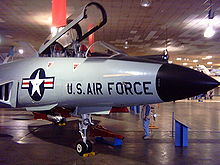
Picture - F-101B at Wings Museum, 2007.
Sheppard AFB, Wichita Falls, Texas (F-101C AF Ser. No. 56-0009)
Strategic Air and Space Museum, adjacent to Offutt AFB, Ashland, Nebraska, (F-101B AF Ser. No. 59-0462)
Travis Air Museum, Travis AFB, California (F-101B AF Ser. No. 58-0285)
Valiant Air Command Warbird Museum, Space Coast Regional Airport, Titusville, Florida (F-101B AF Ser. No 59-0400); this aircraft was previously located at the Sun 'n Fun aviation complex at Lakeland Linder Regional Airport in Lakeland, Florida
Wings Over the Rockies Air and Space Museum (former Lowry AFB), Denver, Colorado,(F-101B AF Ser. No. 58-0271)
Yankee Air Museum, Belleville, Michigan, (F-101B AF Ser. No. 56-0235) This aircraft was assigned to Wright-Patterson AFB from July 1960 until its retirement to the National Museum of the United States Air Force in 1970. Prior to 1970, it was used extensively for ejection seat testing. It was moved to Michigan on loan from the National Museum of the U.S. Air Force in the early 1980s.
Harry Ollrich American Legion Post #4, Mount Clemens, Michigan has a F-101, AF Ser. No. 57-430?, on static display on its front lawn.
Chattanooga Metropolitan Airport, Tennessee Air National Guard, 241st Engineering Squadron has a F-101, AF Ser. No. Unknown, on static display by the front entrance to the base.
Specifications (F-101B)
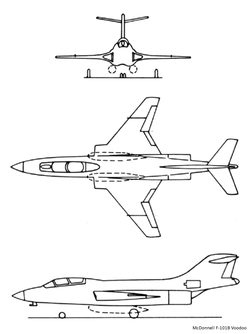
Picture - Line drawings for the F-101B.
Data from The Great Book of Fighters
General characteristics
Crew: 2
Length: 67 ft 5 in (20.55 m)
Wingspan: 39 ft 8 in (12.09 m)
Height: 18 ft 0 in (5.49 m)
Wing area: 368 ft² (34.20 m²)
Airfoil: NACA 65A007 mod root, 65A006 mod tip
Empty weight: 28,495 lb (12,925 kg)
Loaded weight: 45,665 lb (20,715 kg)
Max takeoff weight: 52,400 lb (23,770 kg)
Powerplant: 2x— Pratt & Whitney J57-P-55 afterburning turbojets
Dry thrust: 11,990 lbf (53.3 kN) each
Thrust with afterburner: 16,900 lbf (75.2 kN) each
Internal fuel capacity: 2,053 gal (7,771 l) or 2,953 gal (11,178 l) with two external tanks
Performance
Maximum speed: Mach 1.72 (1,134 mph, 1,825 km/h) at 35,000 ft (10,500 m)
Range: 1,520 mi (1,320 nm, 2,450 km)
Service ceiling: 58,400 ft (17,800 m)
Rate of climb: 49,200 ft/min (250 m/s)
Wing loading: 124 lb/ft² (607 kg/m²)
Thrust/weight: 0.74
Armament
Missiles: 4x— AIM-4 Falcon or 2x— AIM-4 Falcon and 2x—AIR-2 Genie nuclear rockets
Avionics
Hughes MG-13 fire control system
Aircraft type badges
Voodoo One-O-Wonder badge worn by USAF and RCAF/Canadian Forces Voodoo pilots
Voodoo Scope Wizard badge worn by USAF and RCAF/Canadian Forces Voodoo navigators
Voodoo Medicine Man badge worn by USAF and RCAF/Canadian Forces Voodoo maintenance personnel
Century Series
Fisher FP-101 - aircraft with a similar designation
Related development
XF-88 Voodoo
CF-101 Voodoo
Comparable aircraft
F-106 Delta Dart
F-4 Phantom II
Lavochkin La-250
Tupolev Tu-28
Related lists
List of fighter aircraft
List of military aircraft of the United States
Bibliography
Angelucci, Enzo. The American Fighter. Sparkford, Somerset, UK: Haynes Publishing Group, 1987. ISBN 0-85429-635-2.
Characteristics Summary, F-101B, dated 16 August 1960.
Dorr, Robert F. "McDonnell F-88/F-101 Variant Briefing". Wings of Fame, Volume 1. London: Aerospace Publishing, 1995. ISBN 1-874023-68-9.
Francillon, René J. McDonnell Douglas Aircraft since 1920. London: Putnam, 1979. ISBN 0-370-00050-1.
Francillon, PhD., René J. "It's Witchcraft: McDonnell's F-101 Voodoo". Airpower, Vol. 10, no. 3, May 1980.
Green, William and Gordon Swanborough. The Great Book of Fighters. St. Paul, Minnesota: MBI Publishing, 2001. ISBN 0-7603-1194-3.
Gunston, Bill. Fighters of the Fifties. Cambridge, UK: Patrick Stephens Limited, 1981. ISBN 0-85059-463-4.
Hansen, Chuck. U.S. Nuclear Weapons. Arlington, Texas: Aerofax Inc., 1988. ISBN 0-517-56740-7.
Hobson, Chris. Vietnam Air Losses: United States Air Force, Navy and Marine Corps Fixed-Wing Aircraft Losses in Southeast Asia, 1961-73. North Branch, Minnesota: Specialty Press, 2002. ISBN 1-85780-1156.
Jones, Lloyd S. U.S. Fighters: Army Air-Force 1925 to 1980s. Fallbrook, California: Aero Publishers, Inc., 1975. ISBN 0-8168-9201-6.
Kinsey, Bert. F-101 Voodoo (Detail and Scale; vol. 21). Blue Ridge Summit, Pennsylvania: Tab Books, 1986. ISBN 0-8306-8131-0.
Knaack, Marcelle Size. Encyclopedia of US Air Force Aircraft and Missile Systems: Volume 1 Post-World War II Fighters 1945-1973. Washington, DC: Office of Air Force History, 1978. ISBN 0-912799-59-5.
Peacock, Lindsay. "The One-O-Wonder". Air International, Volume 29, No. 2, August 1985, pp. 75-81, 93-95. ISSN 0306-5634.
Taylor, Michael J. H., ed. "The McDonnell Voodoo". Jane's American Fighting Aircraft of the 20th Century. New York: Modern Publishing, 1995. ISBN 978-0792456278.
United States Air Force Museum Guidebook. Wright-Patterson AFC, Ohio: Air Force Association, 1975 edition.
McDonnell F-101 Voodoo Pictures and McDonnell F-101 Voodoo for Sale.
Living Warbirds: The best warbirds DVD series.
Source: WikiPedia